Patriots Draft Preview 2025: Tight ends/fullbacks
Heading into the 2025 NFL Draft, tight end is less of an immediate need for the New England Patriots that some other spots. Hunter Henry and Austin Hooper both return in 2025 after being one of the better tight end duos in the NFL last year – they led the way as the Patriots ranked sixth in both catches and yards by tight ends in 2024.
While those two are on the top of the depth chart, it’s all questions after that. The only other true tight ends currently on the depth chart are 2024 rookies Jaheim Bell and Jack Westover. Bell caught two passes in 15 games, while Westover appeared in three games and played a total of nine offensive snaps without a target.
So while the need is not immediate, it is there. At the very least, the team could look to tap into a strong tight end class finding value in the later rounds to add competition for the third tight end spot, or add a dynamic the other two don’t bring.
At the same time, tight end should be an important position for the team moving forwards. It’s one Josh McDaniels has prioritized historically, and one Drake Maye made heavy usage of last year. With Henry and Hooper both over 30 and Hooper on a one-year deal, it might make sense to get ahead of things in terms of finding the next guy.
The development track for tight ends is typically longer than other positions. Knowing it will be a need in a few years, the Patriots could also look to get aggressive and take a tight end higher, turning that third tight end role into a developmental spot.
Who are the names to know? As we’ve done with other positions so far we’ll look at the players available in the top 100, and other potential Patriots fits later on. We’ll also touch on fullbacks, who typically group together with tight ends.
First round
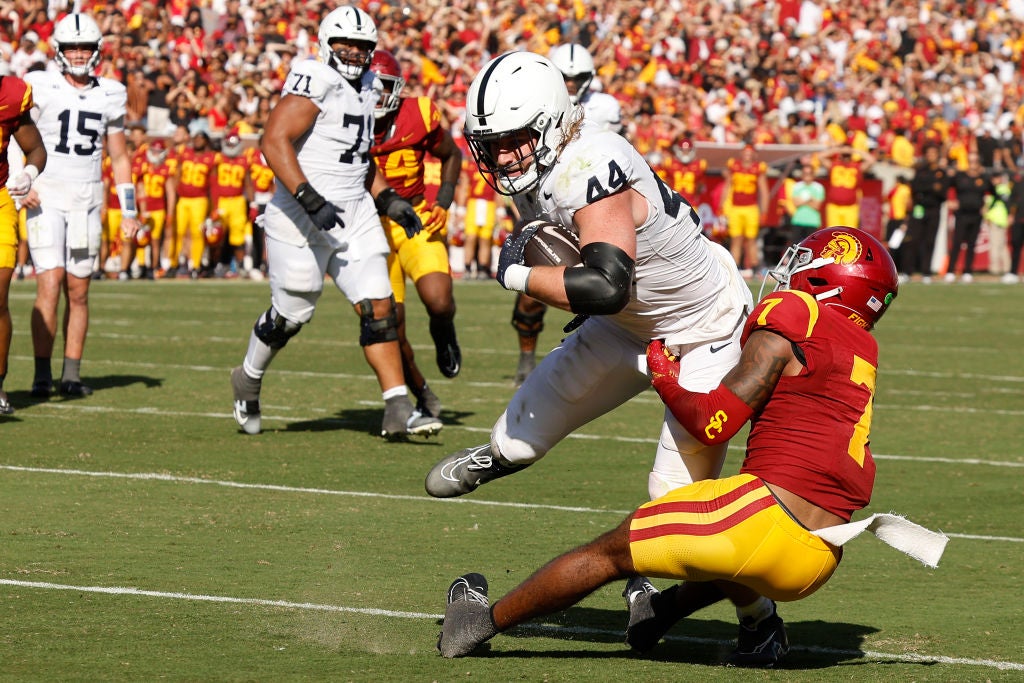
Two tight ends project to go in the first round of this year’s NFL Draft. They are Tyler Warren from Penn State and Colston Loveland from Michigan.
Tight end is becoming a do-it-all position in the NFL, and few players did more than Warren did for the Nittany Lions in 2024. He lined up inline, in the slot, out wide, in the backfield, as a Wildcat quarterback (where he completed 3-of-6 passes for 35 yards and a touchdown), and on one trick play even lined up at center, snapped the ball, and then ran downfield and caught the touchdown.
At 6-foot-5, 256 pounds Warren has ideal size for the position, and his play strength and power reflect that. At the same time he is a smooth route runner with strong hands who can create after the catch. As expected based on his frame, he’s a contributor as a blocker as well. Evaluators also rave about his character and leadership.
Questions about Warren involve his age and experience. He’ll be a 23-year-old rookie, and he failed to long any significant production before his redshirt senior year in 2024 when he caught 104 passes for 1,233 yards and eight touchdowns. Because of that Warren falls into the category of a ‘late breakout player.’ Sometimes when players don’t produce until their final year of college, teams will chalk it up to pure experience rather than skill (this was something that was talked about last year with Jayden Daniels and Michael Penix). Such players can be viewed to have a limited ceiling.
That’s not a guarantee though, and ceiling aside Warren looks to be an NFL-ready contributor, especially compared to the average tight end prospect. Teams looking for instant impact should have him high on their boards.
Loveland was viewed as the top tight end in this draft coming into the season, before Warren’s breakout. He remains a projected first round pick but is expected to go a little later, and would be a more likely candidate for the Patriots if they either trade down from No. 4 or up from No. 38.
At 6-foot-6, 248 pounds Loveland is more of a true receiving threat. He’s an advanced route runner and plus athlete who is a true mismatch when lined up in the slot or out wide – the kind of tight end that is too quick for linebackers in coverage, and too big for safeties. He remains a threat once he has the ball in his hands.
However, Loveland wasn’t able to flex those abilities regularly in Michigan’s run-heavy offense. That makes him a bit more of a projection, as his role in an NFL offense will likely be more involved than it was in college. A shoulder injury cost him time in 2024, which also hurt his draft stock.
In the copycat league that is the NFL, teams will be looking for ‘the next Brock Bowers.’ Warren and Loveland both win differently than Bowers does but have a chance to be impact players, so they could go off the board quicker than expected.
Day 2
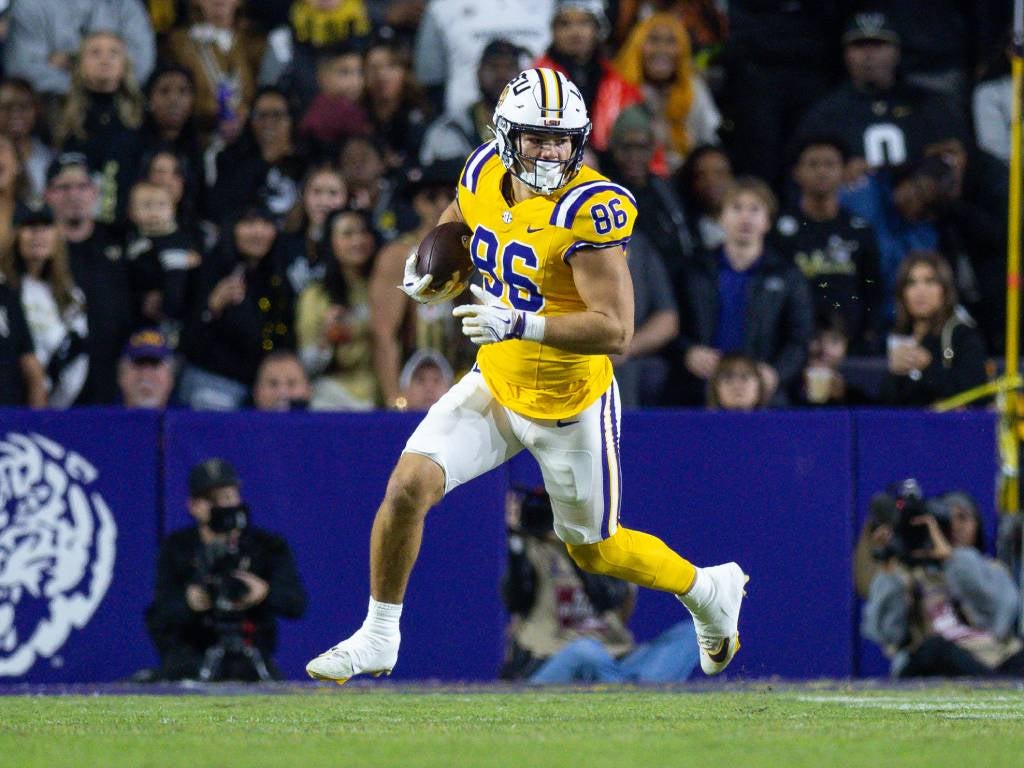
The tight end class isn’t as deep on Day 2. Four players project to go somewhere in this range.
At the top of that group is LSU’s Mason Taylor. Taylor – the son of Miami Dolphins legend Jason Taylor – won’t turn 21 until May and is coming off of his true junior season, but you wouldn’t know it by watching him play. His game is incredibly polished for this point in his career, both in terms of his technique (as a receiver and blocker) and ability to read the field – which was readily apparent at the Combine. He’s an average athlete at the position at 6-foot-5, 251 pounds, but has many other ways to win from traditional tight end assignments.
If it’s athleticism a team is looking for at this point in the draft, the player teams may target is Elijah Arroyo from Miami. After missing chunks of the 2022 and 2023 seasons due to knee injuries Arroyo stayed healthy in 2024 and showed he can be an explosive option in the passing game at 6-foot-5, 250 pounds. He was tracked at 21.8 MPH during the 2024 season, the fastest of any tight end. Right now he’s more of a big play threat than a chain mover and will need to refine his route-running and blocking to fill a more regular role, but he has some outstanding raw tools.
However, the player with the best raw makeup is Harold Fannin Jr. from Bowling Green. At 6-foot-3, 241 pounds Fannin is more of an H-back than a true tight end, and is at his best with the ball in his hands. He plays faster than his 4.71-second 40 indicates, which allows him to be a threat at multiple levels. His route running needs to improve, and he doesn’t project to add much as a blocker.
As is the case with most small school prospects, level of competition is a question for Fannin. He did dominate two Power Four teams this year with massive games against Penn State (11 catches for 137 yards) and Texas A&M (8 catches for 145 yards), but underperformed at the Senior Bowl and Combine. That leaves his stock with more variation than most tight ends in the draft – it’s just as easy to see him going early in the second round as it is to see him falling out of the top 100 entirely.
The final player in this range is Gunnar Helm from Texas. Helm is a quarterback friendly tight end who regularly separates from defenders with strong route running and has reliable hands. In a Texas offense full of big play threats, he was regularly used as a chain mover. He also projects to be a factor as a blocker in the NFL.
Helm is another player whose draft stock is tough to project. He’s another late-breakout player, with 60 of his career 79 catches and 786 of his 1,022 yards coming last season as a senior. A 4.84 40 at the Combine seemed to be a further blow to his projection, but it was later revealed he ran the drill with a sprained ankle.
Early Day 3
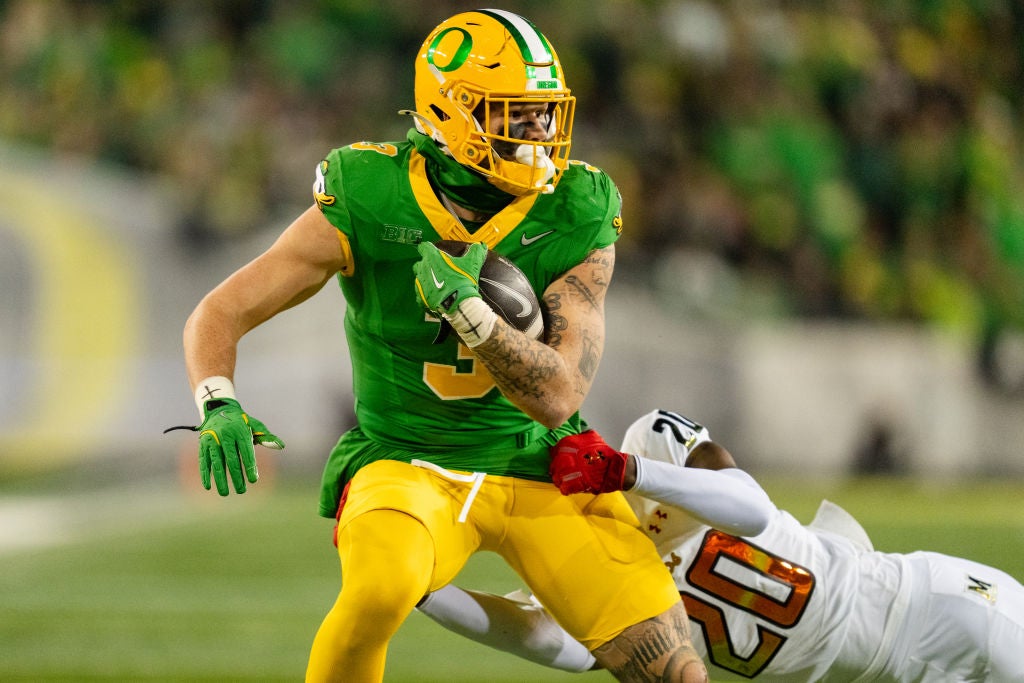
At this point in the draft, we’re looking at players who are more future projects than immediate impact players. We’ll start with a player who could step in for Hooper and/or Henry down the road, with a similar play style.
Terrance Ferguson from Oregon is an overall receiving tight end. At 6-foot-5, 247 pounds Ferguson can win with both raw athleticism and route running, and has strong ball skills that allow him to make the most of his frame. That showed up during his strong Senior Bowl performance. However Ferguson’s blocking needs to improve for him to be an every-down player in the NFL.
The more well-rounded option in this range is Mitchell Evans from Notre Dame. At 6-foot-5, 258 pounds Evans can win physically both as a pass catcher and run blocker. He’s mainly an inline option but can play from the slot, where his catch radius can make him a tough matchup.
Evans was limited in two ways during his college career, both of which impact his draft stock. He played just eight games in both 2022 (foot injury) and 2023 (torn ACL), and like Loveland he didn’t get to show what he’s fully capable of as a receiver in Notre Dame’s run-first offense. He’s more of a project, but if he can be one of those players who makes a stride two years removed from an ACL tear he has a chance to be a reliable option in an NFL offense.
For those looking for a ‘move’ tight end Jake Briningstool from Clemson is the player in this range. He’s more of a catch-and-run player who is best with the ball in his hands. He can also contribute as a blocker.
All three of those players would likely slot in behind Henry and Hooper in similar roles for the Patriots in 2025. More immediate impact may come from a third tight end who is more of a pure blocker. If that’s the direction the team decides to go then Jackson Hawes should be an option. At 6-foot-4, 253 pounds he plays bigger than his listed size and is a mauler at the line of scrimmage, but doesn’t have the pass catching skills or upside of other tight ends in this range.
Late Day 3
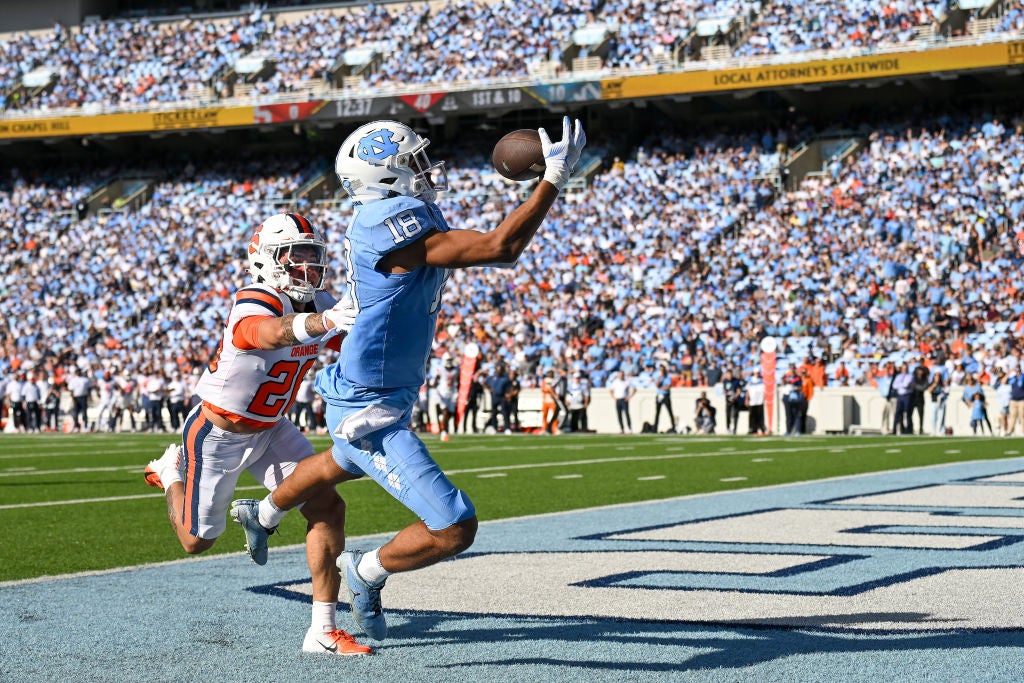
You can’t have a tight ends watch list without talking about Iowa. The latest player to come from the Hawkeye tight end pipeline is Luke Lachey. He’s got great hands and can go outside of his 6-foot-6, 251-pound frame and fight through contact to make catches, but that will be tougher to do regularly at the NFL level. He’ll need to find other ways to get open as a pro, where he’ll fit better as a chain mover. His blocking can also improve.
If the Patriots are going to focus on schools when looking at this tight end draft though, they might start with North Carolina and Bryson Nesbit. One of Maye’s top targets from his time in college, Nesbit was originally projected to go higher in this draft but was impacted by poor quarterback play before losing the second half of his season outright due to a wrist injury in 2024.
When healthy, Nesbit is a pure receiving tight end who plays more like a big slot receiver at 6-foot-5, 238 pounds. He’s more of a vertical threat than volume option, which isn’t the case for most of the tight ends in this class. His experience with Maye, especially when it comes to syncing up on downfield throws, could give him more value to the Patriots in this draft than the average team.
Nesbit might play like a wide receiver, but Oronde Gadsen II (son of the NFL receiver with the same name) actually was a wide receiver before converting to tight end in 2022. At 6-foot-5, 243 pounds Gadsen is also more of a field stretcher and could be an option for the Patriots if they want to draft a player similar to Nesbit for Maye but can’t get Nesbit himself. He has better hands than Nesbit overall, but doesn’t have as big of a catch radius or adjust to throws outside of his frame as well.
Finally we’ll touch on Gavin Bartholomew from Pitt. Bartholomew’s production was very inconsistent at Pitt over the last four years, but that was the case for the Panthers’ offense as a whole. Teams will have to look at the tape and decide if he was simply a product of his environment, or if he’s not consistent enough.
Pitt used Bartholomew mainly as an inline tight end, but he could have the flexibility to do more in the NFL, especially in an H-back role. He plays with a physical edge in everything he does, whether it be in the route, after the catch, or as a blocker at 6-foot-5, 247 pounds. His Combine showed better athleticism than what’s on tape and he may need to be schemed open to be a regular pass catching threat in the NFL.
Fullbacks
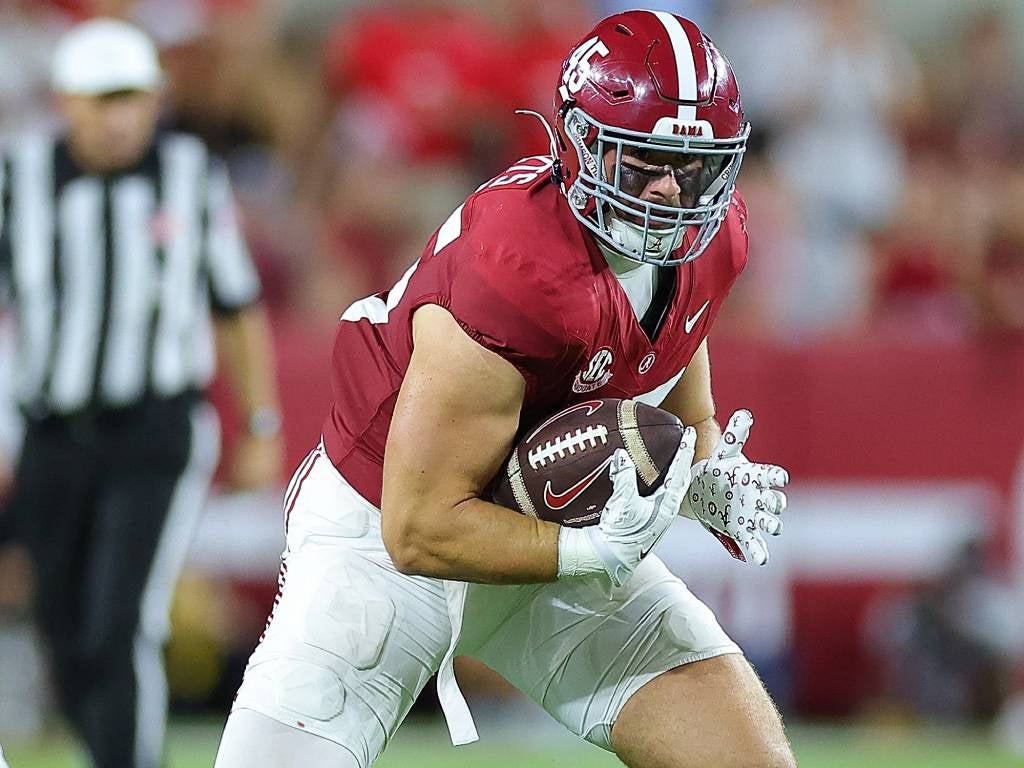
Will the fullback position return to New England along with Josh McDaniels in 2025? If it does, it may look a little different.
In the past the Patriots had pure blocking fullbacks. This time around, is McDaniels looking for more a hybrid player who can contribute in the passing game? That could be the case, based on the signing of Giovanni Ricci, who is a hybrid tight end/fullback that would fit that role. It’s worth noting the Patriots tried to bring in such a player during McDaniels’ last tenure as well. They signed Danny Vitale in 2020, but Vitale opted out during the COVID year then retired and never played a snap for the team.
If the Patriots are going to try to incorporate that position again and are looking for competition for Ricci, there are players in this draft who fit. The top name to know might be Robbie Ouzts from Alabama. At 6-foot-3, 274 pounds Ouzts primarily played tight end and H-back for the Tide with some true fullback experience and is surprisingly nimble for a player his size in the passing game.
Still, a move to a multi-role fullback (something Ouzts has talked about before) is most likely as his true strength is as a blocker. Ouzts also should be at least somewhat familiar with McDaniels’ overall offensive concepts, after playing for Bill O’Brien at Alabama – something he talked about at the Combine. He also projects as a core special teams player.
Brock Lampe from Northern Illinois is another tight end who will likely make the move to fullback in the NFL. At 6-foot-1, 252 pounds the Huskies would occasionally put the ball in Lampe’s hands in both the running and passing game, but he was mainly used as a battering ram to lead the way for a team that averaged over 200 yards per game on the ground.
The Patriots likely won’t need to overextend to get either player. Both are currently projected to go undrafted, but could sneak into the later rounds to a team looking to ensure it gets the fullback it wants.



